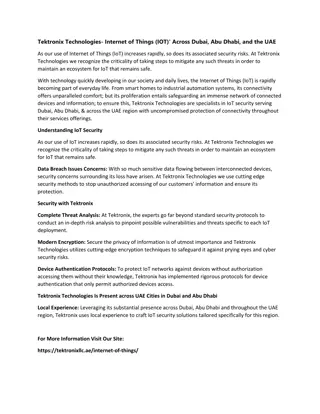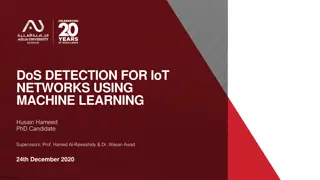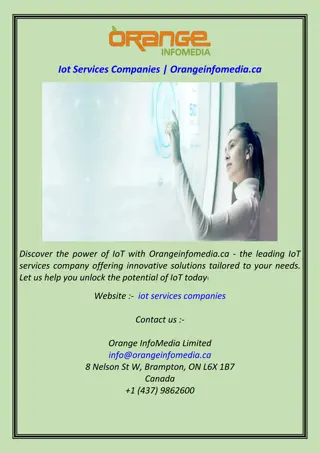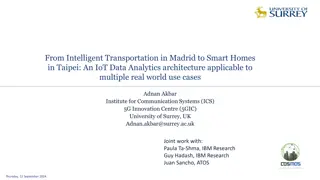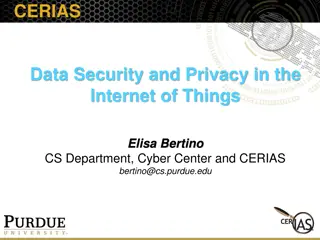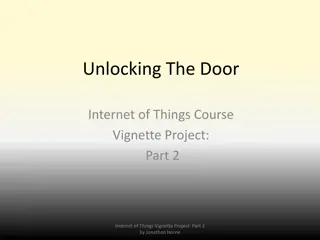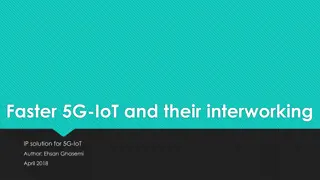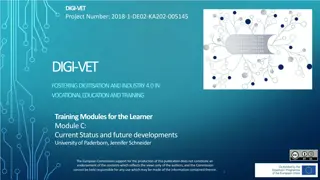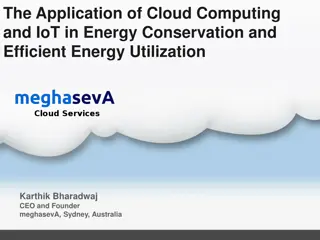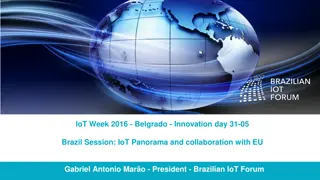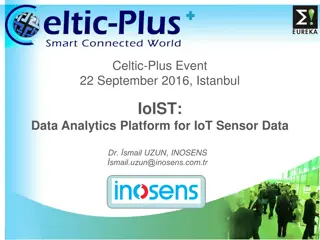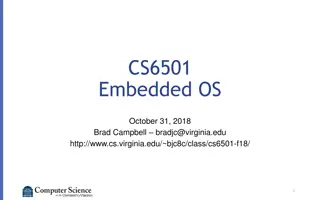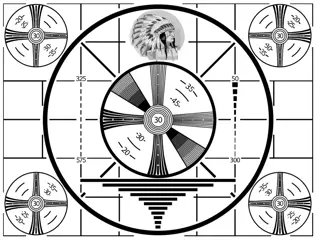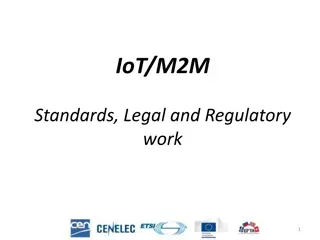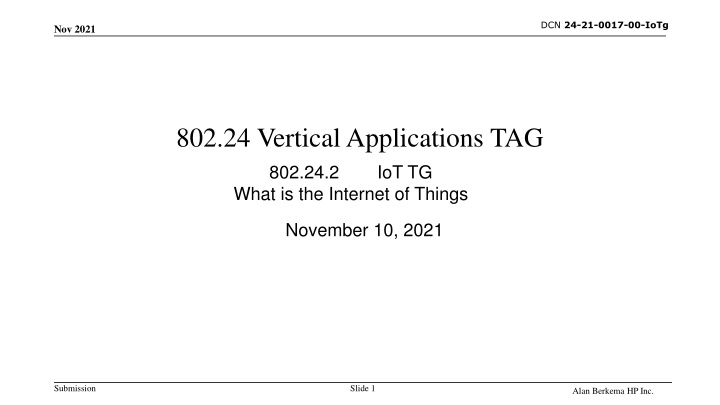
What is the Internet of Things (IoT): A Comprehensive Overview
The Internet of Things (IoT) refers to a network of physical objects embedded with technology to communicate and interact with the environment. It enables advanced services by connecting various devices and systems. The concept involves sensors collecting data and actuators responding to changes in the physical world. IoT devices interact with the physical world through sensing or actuating, forming an interconnected infrastructure of entities, systems, and resources. The IoT vocabulary defines entities such as devices and gateways within IoT systems. This emerging technology revolutionizes how everyday objects communicate and gather data intelligently across networks.
Download Presentation

Please find below an Image/Link to download the presentation.
The content on the website is provided AS IS for your information and personal use only. It may not be sold, licensed, or shared on other websites without obtaining consent from the author. If you encounter any issues during the download, it is possible that the publisher has removed the file from their server.
You are allowed to download the files provided on this website for personal or commercial use, subject to the condition that they are used lawfully. All files are the property of their respective owners.
The content on the website is provided AS IS for your information and personal use only. It may not be sold, licensed, or shared on other websites without obtaining consent from the author.
E N D
Presentation Transcript
DCN 24-21-0017-00-IoTg Nov 2021 802.24 Vertical Applications TAG 802.24.2 What is the Internet of Things IoT TG November 10, 2021 Submission Slide 1 Alan Berkema HP Inc.
What is the Internet of Things DCN 24-21-0017-00-IoTg Nov 2021 The network of physical objects that contain embedded technology to communicate and sense or interact with their internal states or the external environment. (Gartner) A global infrastructure for the information society, enabling advanced services by interconnecting (physical and virtual) things based on existing and evolving interoperable information and communication technologies. (IoT-GSI) IoT describes a world where just about anything can be connected and communicate in an intelligent fashion. In other words, with the Internet of Things, the physical world is becoming one big information system. (Techopedia) It s a concept of everyday objects from industrial machines to wearable devices - using built-in sensors to gather data and take action on that data across a network. (SAS Institute) Submission Alan Berkema HP Inc.
IoT Sensors DCN 24-21-0017-00-IoTg Nov 2021 Sensors collect data from the environment or object under measurement and turns it into useful data. Submission Alan Berkema HP Inc.
Sensors and Actuators DCN 24-21-0017-00-IoTg Nov 2021 A sensor is a device that responds to any change in physical phenomena or environmental variables like heat, pressure, humidity, movement etc. and turns that into to a more usable form. Sensors contain a transducer is a device that converts energy from one form to another An actuator is a device that is responsible for moving or controlling a mechanism or system. It is operated by a source of energy, which can be mechanical force, electrical current, hydraulic fluid pressure, or pneumatic pressure, and converts that energy into motion. Submission Alan Berkema HP Inc.
ISO/IEC 20924 - Internet of things (IoT) Vocabulary DCN 24-21-0017-00-IoTg Nov 2021 3.2.4 IoT device entity of an IoT system that interacts and communicates with the physical world through sensing or actuating Note 1 to entry: An IoT device can be a sensor or an actuator 3.2.1 Internet of Things - IoT infrastructure of interconnected entities, people, systems and information resources together with services which processes and reacts to information from the physical world and virtual world 3.2.6 IoT gateway entity of an IoT system that connects one or more proximity networks and the IoT devices on those networks to each other and to one or more access networks Submission Alan Berkema HP Inc.
ISO/IEC 20924 - Internet of things (IoT) Vocabulary (cont) DCN 24-21-0017-00-IoTg Nov 2021 3.2.3 IoT conceptual model common structure and definitions for describing the concepts, relationships, and behavior within an IoT system 3.2.7 IoT system system providing functionalities of Internet of Things Note 1 to entry: IoT system is inclusive of IoT devices, IoT gateways, sensors, and actuators. 3.2.5 IoT domain major functional group of an IoT system Note 1 to entry: Every entity in an IoT system participates in one or more IoT domains and is said to be included or contained by that domain. Note 2 to entry: The IoT domain consists of six domains: user domain, operation & management domain, application & service domain, resource access & interchange domain, sensing & controlling domain, physical entity domain. Submission Alan Berkema HP Inc.
IEEE P2413/D0.4.6, March 2019 Draft Standard for An Architectural Framework for the Internet of Things (IoT) DCN 24-21-0017-00-IoTg Nov 2021 It is important to understand what the Internet of Things is and what the difference is between the IoT environment and an IoT system. A simple definition of an Internet of Things system is a system of entities (including cyber-physical devices, information resources, and people) that exchange information and interact with the physical world by sensing, processing information, and actuating. The set of IoT components available to be composed into IoT systems, the networks connecting the components, and any associated services that provide the mechanisms for discovery, composition, and orchestration can be called an IoT environment. Core to the idea of IoT is this interaction with physical entities. An entity of interest is a physical entity that is of interest to a human or organization for the completion of a goal. A physical entity is a discrete, identifiable part of the physical environment. Physical entities can be any physical object: humans; animals; cars; store or logistics-chain items; mechanical devices; computing devices; etc. Submission Alan Berkema HP Inc.
Not the Internet of Things Smart Devices DCN 24-21-0017-00-IoTg Nov 2021 Wi-Fi IoT Device Specific Apps Wi-Fi Submission Alan Berkema HP Inc.
Approaching IoT DCN 24-21-0017-00-IoTg Nov 2021 Local Power Company Lower power consumption during energy rush hour Switches to away mode when you leave the house Wi-Fi IoT Device Specific App Controls a system of devices Wi-Fi Submission Alan Berkema HP Inc.
Internet of Things (IoT) IBM Vision DCN 24-21-0017-00-IoTg Nov 2021 More Things Connected than People Intelligent System of Systems Connecting the Planet Generating enormous amounts of Data Determine patterns in the Data for greater efficiencies IDC revealed its prediction that the global IoT market would hit $7.1 trillion by 2020 Wisdom Intelligence & Analytics Knowledge People make better Decisions Information http://tintuc.hocmai.vn/images/stories/anh_tin_tuc/Icon/mui_ten_5.png Data Submission Alan Berkema HP Inc.
Vertical Markets DCN 24-21-0017-00-IoTg Nov 2021 Smart Home smart speakers, virtual assistants, camera doorbells, lighting control, thermostats Smart Cities - smart parking, mass transit, traffic, public safety, energy management Smart Buildings control lighting and energy usage Connected Cars self driving, safer for passengers and other road users, infotainment, navigation Connected Retail - supply chain, customer experience, and new channels & revenue streams Wearables - smart bands, smart watches and other wearable devices capable of collecting, sending and processing data over mobile applications Health Care patient monitoring Industrial - sensors to gather data for analyzing and optimizing manufacturing processes Agriculture the connected cow Transportation and Logistics - operation processes are automated for solutions such as fleet management, asset tracking and predictive maintenance Telecom - device certification and monitoring can deliver predictive failure insights, usage pricing Submission 11 Alan Berkema HP Inc.
Internet of Things - Maintenance Use Case DCN 24-21-0017-00-IoTg Nov 2021 IoT-based predictive maintenance allows you to systematically schedule the optimal maintenance and inspection routine to avoid unplanned downtime and unnecessary effort. Avoidable costs can be greatly reduced, and you can also reduce the amount of time the machinery or equipment is down for maintenance. Gartner estimates that through 2022, decision automation in the form of predictive maintenance will generate the highest business value for organizations with heavy assets. Businesses in asset-intensive industries struggle to maintain a balance between keeping costs down and asset availability up. Effective asset management and maintenance play a key role in ensuring that this balance is maintained enabling these businesses to comply with regulations, avoid the costs associated with unnecessary maintenance, and avoid unplanned downtime. According to a report by PwC, on average, predictive maintenance in factories could: Reduce costs by 12% Improve uptime by 9% Reduce safety, health, environment, and quality risks by 14% Extend the lifetime of an aging asset by 20% Submission Alan Berkema HP Inc.
Internet of Things Devices? DCN 24-21-0017-00-IoTg Nov 2021 Are Personal Computers, Mobiles Phones, Printers or Smart TVs IoT devices? Submission Alan Berkema HP Inc.

